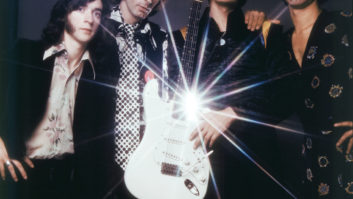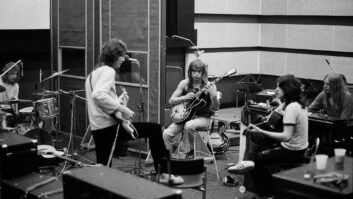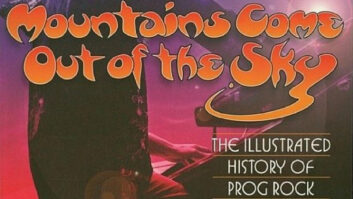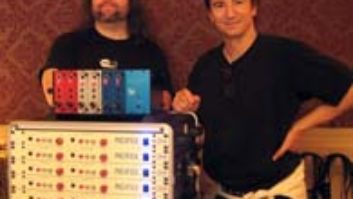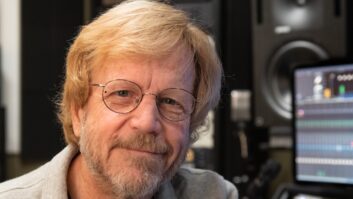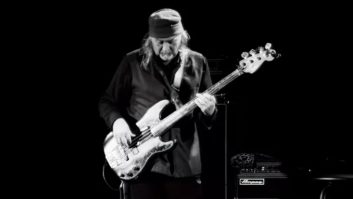The British are different. Tea instead of coffee, soccer over football, cricket instead of baseball, not to mention driving on the “wrong” side of the road. So it should come as no surprise that the English approach to playing and recording jazz is a bit different, too. “We bring a particular Britishness to the classic sound of acoustic jazz,” says drummer/producer Bill Bruford, speaking from his home outside of London regarding his latest project The Sound of Surprise.
The recording is essentially neo-mainstream jazz, but with some interesting compositional and rhythmic quirks that could only come from England. Bruford characterizes it as falling somewhere between the current CDs of American saxophonist Joshua Redman and British bassist Dave Holland. It was recorded last fall with Bruford’s longstanding group, Earthworks, now in its unamplified “second edition” format since 1998. “It’s in my background,” Bruford continues. Referring to the titles of the tunes, such as “Revel Without a Pause,” “Come to Dust,” “Cloud Cuckoo Land” and “Never the Same Way Once,” he says, “These are not American titles. Even the artwork is different; it’s just not an American CD. Great American CDs there are, but we also feel now that jazz is an international sport. And there are plenty of guys in Europe eager to contribute.”
Elaborating further, he notes, “From an Englishman, you’d expect economy, understatement, elegance and effortlessness. If I’m not any of those things, then shoot me. But if you listen to the recording, you’ll find all those things all over it. I think American jazz is based more on the blues, or probably is closer to the blues. Usually, it’s not long before some American jazzologist is going to play something pretty much approaching the blues. Not necessarily true here. Here, the improvisational quality comes more from contemporary classical or art music.”
Bruford’s latest contribution to jazz picks up where he left off with Earthworks in 1999, with A Part, and Yet Apart. Most important to the bandleader — a progressive rock icon highly regarded for his work with King Crimson, Genesis and Yes — was that the recordings sound like they came from the same band. “I’m thrilled with this band,” he says, referring to pianist Steve Hamilton, reeds player Patrick Clahar and bassist Mark Hodgson. “We’re a strong working outfit. Everybody is beginning to pull together so that the band has an energy and organic feel all its own. Whereby if you replaced anybody, it wouldn’t be quite the same. And I like that, especially coming from a rock background. I like that steady working band vibe.”
That vibe is also the basis of his recording style. After painstakingly taking three months to create the compositions, Bruford and the group “road tested” them on a 22-city tour around the UK tweaking the new material. About eight months after Bruford originally conceived the project, the band went into the studio to record.
“It’s a great way to record jazz,” Bruford emphasizes, “because everybody gets familiar with the mechanics of the music during the tour. And the fun can start quicker as soon as you get the difficult bit about learning the music and so forth. Once you get that, it makes the recording of the album relatively easy. I heartily recommend that — it keeps your studio costs down, people know what they’re doing and they know what they’re going to get out of a solo on a given composition. Some of my favorite solos, for example, are Patrick’s on ‘Count to Dusk,’ a very slow tenor solo. And I particularly like the polyrhythmic stuff on ‘Triplicity,’ which is a rather strange seven-note rhythm in 6/8.”
Bruford adds that by playing the material live first, his compositions get to breathe and develop further, if necessary. After playing a selection several times, it often becomes obvious that an alteration of some type might be needed. When in a studio putting it down for posterity, it’s often too late or too costly for creative changes. He explains further, “Sometimes you need the composition to tell you what it wants you to do. A month’s worth of steady road work will help you do that.”
Needless to say, the tracking and mixing of the CD, done at Livingston Studios in London last November, was a brisk affair. The previous Earthworks disc was also recorded at Livingston, which Bruford favors because of its spaciousness, great mic selection and good-sounding booths. Sessions were completed in just three days and required very little out of the ordinary in terms of engineering expertise. “I try to forget projects once they’re finished,” remarks Mark Chamberlain, engineer for the recording. “Especially something you’ve worked on intensely. It was done in quite a small space of time; we recorded and mixed pretty close together. I personally like a gap between the two. Because of the time, that wasn’t ideal.
“It’s very much just four guys playing in a room with a lot of concentration. Really, it was about performances; that was the thing. You’re trying to get as natural a sound as possible, without a lot of sequencers and all that other stuff. However, we did use a Sony reverb system, the 777, where actual samples from concert halls are used instead of algorithmic echoes. We chose some American hall in Chicago as a general ambience around everything.”
Bruford’s drum set, a 20-year-old Toma Star Classic, provided some miking challenges for Chamberlain. “His kick is set up differently from other people’s,” he says. “He plays it with a snare extensile, the hi-hat and remote pedal, and two tom-toms are on either side of the snare. They’re tuned differently, so it is a bit weird. It’s similar to a timpani setup and his cymbals are very low. So that’s a bit of a challenge with the cymbal ring being very near the tom-tom mic and stuff like that. You have to address those items with very careful miking.”
Recalling other aspects of the recording, Chamberlain continues, “I recorded the bass on two tracks, one with the compressor on and one without. So I’m never committed to either, and I can use the original signal if there aren’t any problems. The important things were careful mic techniques and getting it right to start with on tape. Also, with four people, the crucial thing was all of them being very comfortable in the studio with headphone balances. The simpler the sessions get, the more complex things like that become, because you’ve got four guys who want to hear their own mixes. And what they hear is crucial to how they perform. A lot of that was set up prior to the sessions and worked quite well. We used some clever wiring with the SSL and managed to split some of the channels. The board used for the sessions was an SSL with Massenburg mic amps. Sound quality is somewhat unique and differs greatly from what is usually expected from the well-known manufacturer. “It’s quite old,” Chamberlain points out, “and Jerry [Boys], the guy who runs the studio, has heavily customized the EQ and mic amps. It sounds unlike any SSL I’ve ever worked on. It’s much, much warmer and the headroom seems better, so you crack it a bit more than you can normally.”
Mixing was done efficiently on an Amek Rembrandt system in a much smaller room. Chamberlain had nothing but praise for the equipment, especially because he finished ahead of schedule. “The signal path is very simple. For the type of mixing we were doing, it was perfect, because it didn’t over-complicate things. The computer does very simple automation such as muting and tightening things up. Normally, you record in a smaller room and mix on an SSL, but we didn’t do it that way. We did it this way for the previous CD, and it worked really well.”
Bruford typically would come in after everything was set up and go over mixing details with Chamberlain. From there, it was solely in the engineer’s hands, with Bruford having ultimate approval. Chamberlain sums up his working relationship with Bruford: “He knows what he wants to hear basically, and he’ll let you know whether he’s happy or not.”
Of the mixing he notes, “We were doing three tracks a day and although there were only four people in the band, it actually was quite complicated. There were a lot of changes going on and a lot of housekeeping involved because of all the takes. Naturally, everyone had their favorite, so a lot of listening went on before I did the mixing. The challenge really was just trying to get the best that you can out of it. And it was different than most jazz, because it sounds quite big. There’s a rock element to it, especially on the drums. So it’s caught between two stones with the jazz thing and aggression on some of the tracks, which is quite nice. Getting that out is good, but getting it to sit with the quiet tracks is important, too. As we started putting tracks down, Bill starting worrying about the drums sounding too ‘live,’ so we started shutting the room down a little. So there’s a bit of fiddling around from track to track, moving screens just to get more room on the overheads.”
Bruford’s many fans will, of course, be checking out his performance on the CD, and they might be surprised to hear that the immense, thundering electronic drum sound of early Earthworks albums has been exchanged for a natural, refined and spacious type of playing. He affirms his acoustic direction. “Certainly, as far as Earthworks is concerned, I think there was a golden age of electronic drums. In the ’80s and mid-’90s, they were full of promise. And, frankly, my work with King Crimson and Earthworks took an electronic drum set about as far as it possibly could go in terms of live performance.”
Still, he notes, “I feel that my role in this [second-edition Earthworks] is pretty prominent. It’s not what you’d call a drummer’s CD, where the drummer plays a solo every two minutes. There are two or three solos on the album; I think that’s probably sufficient from me. I prefer to be deceiving — the guy in the back not doing much — but if you took away my contribution, you might find that the thing would collapse. If you’re a young kid looking for blazing drums, you may have to look somewhere else. The real pleasure for me is sitting back with guys who played the music, listening to it and saying, ‘Yeah!’”
